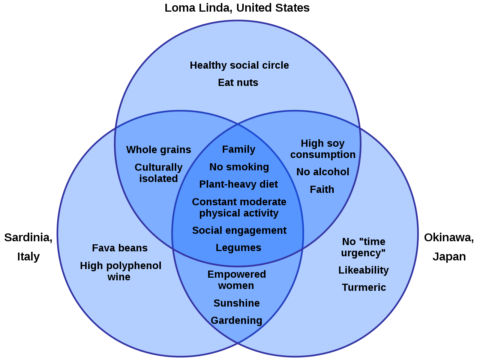The Blue Zones where people live longer may be a myth. The Blue Zone Diet is based on speculation, not solid science.

The so-called Blue Zones are geographical locations where people are said to live longer than elsewhere. These include Sardinia, Okinawa, Loma Linda (California), the Nicoya Peninsula in Costa Rica, and Icaria, Greece. They have been studied looking for common factors that might promote longevity. Some of the common factors: these are people who live in tight knit communities, they eat well, following a Mediterranean or plant-based diet, they don’t over-exercise but they have a busy domestic life with energetic chores. The Blue Zone Diet assumes that common dietary factors have been identified and that following the diet will make us live longer. That appears to be a false assumption based on speculation, misinformation, and wishful thinking, not on science.
Blue Zones may be a myth
The claims of longevity in those locations may be based on fraud and error. Record-keeping has been deficient in many of those areas; systematic verification of age has been practiced only recently and only in some parts of the world. People may be confused with parents and grandparents who had the same name. People can misremember. People can lie. The longest verified life span was that of Jeanne Calment of France, who died at age 122.
Loma Linda has a longer-than-average life span. This has been attributed to the large population of Seventh Day Adventists with a healthy lifestyle, but it might just be due to the fact that people who are richer tend to live longer. Similar longevity might be found in other well-to-do locations. There have been no good studies to rule out possible confounders.
The Okinawa claim is now disputed. Overall Japan has the highest life expectancy of any country, but recent data shows that men in Okinawa don’t live as long as men in other Japanese prefectures. A recent commentary in the journal Gerontology pointed out that “Current demographic and nutritional data suggest that the remarkable Okinawan longevity is now a phenomenon of the past”.
Even if they did live longer, it might have nothing to do with their diet
It is simplistic to assume that diet is the reason. There could be any number of confounding factors such as heredity and lifestyle differences. Science has been studying dietary factors that might improve longevity, but it hasn’t come up with any definitive answers. Calorie restriction prolongs life in many animals but the data for primates is mixed, and the concept has not been proven in humans. The positive studies in other animals have involved very severe calorie restriction. Most people would not find such a diet palatable or feasible, and it might be difficult to ensure adequate nutrition. Nevertheless, some optimistic people are already following a very low-calorie diet. The Calorie Restriction website claims that death can be postponed for many years. Time will tell whether their optimism is warranted.
How could there be one Blue Zones diet?
Obviously, the diet of an Okinawan in Japan is markedly different from the diet of a Seventh Day Adventist in Loma Linda, California. The idea of a Blue Zone diet doesn’t make sense, but they thought they could identify enough common factors to devise a diet and lifestyle that would reveal the secret of longevity.
Apparently, the secret to longevity is that there is no secret
The Blue Zone Diet essentially repeats much of the conventional advice for a healthy diet:
A diet similar to the Mediterranean diet, with whole grains, fruits, vegetables, nuts, legumes, seeds, and spices, with meat consumed sporadically, mainly fish and lean meat. Olive oil is preferable to butter. Meat limited to 2 oz. servings twice a week from free-range animals. Avoid processed foods. Up to 3 oz. of fish daily; avoid farmed fish, overfished species, and fish with high levels of mercury, PCBs, or other chemicals. Minimize dairy. No more than 3 eggs per week. At least half a cup of beans daily. Slash sugar (no more than seven added teaspoons a day. Snack on nuts (two handfuls a day). Replace common bread with sourdough or 100% whole wheat bread. Eat whole foods that are recognizable for what they are. Avoid foods wrapped in plastic and foods with more than five ingredients. Try to eat at least three “super blue” foods a day: these include beans, greens, sweet potatoes, nuts, olive oil, oats, barley, fruits, green or herbal teas, and turmeric. To drink: coffee and tea OK; red wine in moderation; avoid soda pop.
To make it easier to remember, there are four “always” foods: 100% whole wheat bread, nuts, beans, fruit. And there are four foods to avoid: sugar-sweetened beverages, salty snacks, packaged sweets, and processed meats.
Some of these guidelines are based on good science; others have been questioned, for instance the idea of “super foods”.
Lifestyle
In Dan Buettner’s book The Blue Zones, he provides these nine lessons that characterize the lifestyles of people who live in the Blue Zones:
- Moderate, regular physical activity
- Life purpose
- Stress reduction
- Moderate caloric intake
- Plant-based diet
- Moderate alcohol intake, especially wine
- Engagement in spirituality or religion
- Engagement in family life
- Engagement in social life
Conclusion: Myth and speculation, not solid science
If you follow these Blue Zone guidelines, will you live longer? Maybe. We simply don’t know yet. Good controlled studies are lacking, and time will tell. Humans live a long time, so the effect of this diet won’t be measurable until many years have passed. In the absence of good data, I’d rather follow the advice of Craig Good’s book which I reviewed last week: relax and enjoy your food.
This article was originally published in the Science-Based Medicine Blog.
